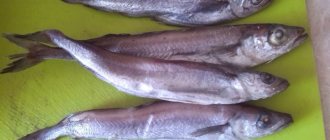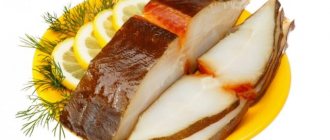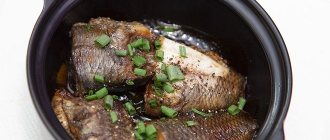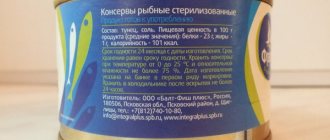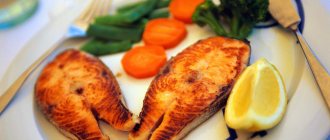High-fat varieties from seas and rivers
It has been proven that any sea or river fish is much healthier for the body than animal meat. Fillet dishes turn out very tender, soft and pleasant. When cooked, river and sea pulp loses a minimal amount of liquid due to the large amount of easily digestible protein and the small amount of connective tissue.
The list of microelements and the level of fat content depends on the habitat of the fish, the age, sex of the fish and the time of year in which it is caught. River varieties contain lower amounts of vitamins A, B and D, iodine and magnesium, but river pulp contains more easily digestible iron.
Sometimes the fillet has a specific smell of mud with algae. The value of dietary fiber from fish from the sea is greater than that from river fish, since the pulp contains a large amount of proteins, vitamins soluble in water, iodine and polyunsaturated acids.
All fish varieties can be divided into the following categories according to the degree of fat content:
- low-fat (up to 3%) – pike perch, crucian carp, pike meat, pollock, mullet, pike, small roach, omul;
- medium fatty (up to 9%) – herring, perch, carp, pink salmon, carp, horse mackerel, tuna;
- high-fat (up to 30% or more) - saury, salmon fillet, lamprey, eel, mackerel, herring, catfish, sturgeon, asp.
Chemical composition and nutritional value
Hake meat is an easily digestible protein with high biological value. 100 g of fillet contains almost 19 g of protein and only around 1 g of fat. Fish meat is rich in vitamins A, B, group B. It contains a lot of magnesium, phosphorus, copper, sodium, iodine, calcium, potassium, sulfur, manganese, iron, fluorine, zinc and some other useful components. This fish is useful as a source of unsaturated fatty acids important for humans, including those from the omega-3 group. And with all this, 100 g of fillet contains no more than 86 kcal.
Beneficial properties of fatty fish
The fat in a fish carcass is concentrated in the intestinal and abdominal areas. Meat can contain up to 30% fat depending on the type of fish, and its volume also increases during the spawning period of fish. The fatty pulp is rich in omega 3 and 6 fatty acids, vitamins, macro- and microelements, which ensures the full functioning of all vital systems of the human body.
Fish pulp is almost completely digestible, which has a complex beneficial effect on the body. Regular consumption of fatty fish reduces the risk of cardiovascular diseases. Phosphorus in the composition improves the condition of tooth enamel, strengthens hair, brightens the skin and strengthens the musculoskeletal system.
Fatty acids work together to reduce cholesterol, enhance tissue regeneration, increase protective function, and improve the condition of bones. The effects of acids activate brain activity, improve immunity and visual acuity.
For baby food, fatty fish is extremely necessary, since vitamins have a beneficial effect on the mental development of children, sharpen attention, improve memory and perception of the surrounding reality.
Valuable elements of fish meat have a calming, activity-suppressing effect, produce happiness hormones and improve mood.
Omega-3. What kind of fish does it contain?
General overview of Omega-3
It is well known that diets rich in Omega-3s are beneficial to health and can be used to prevent disease. Today's consumers are becoming increasingly nutritionally aware and particularly interested in healthy eating and are now actively seeking out omega-3 foods to include in their diets. However, we need to understand what exactly Omega-3 is, what foods contain it, and how much of it we actually need? It's easy for consumers to get lost in the sea of promotions and campaigns, so below we've provided a short but important educational lesson on the benefits of omega-3s.
What is Omega-3?
Omega-3s are long-chain polyunsaturated fatty acids (PUFAs). They are essential for our health, but we cannot synthesize them ourselves. Therefore, we must get them with food, preferably daily. There are Omega-3 fatty acids of different structure, composition and properties. The best known are EPA (eicosapentaenoic acid) and DHA (docosahexaenoic acid).
Where are Omega-3s found?
In nuts and plant sources, for example, omega-3 fatty acids are found in walnuts, soybeans, flax seeds, cauliflower and Brussels sprouts. But the highest levels of these fatty acids have also been proven in fish and seafood. Omega-3s are found most abundantly in fish, such as sardines, tuna, salmon and herring. And also in less used seafood such as eels, krill and seaweed.
How much Omega-3 do we need?
A daily intake of 250 mg EPA+DHA for an adult provides optimal protection against disease. For example, research has shown that this amount is sufficient to protect against coronary heart disease. Research also shows that 150 mg of omega-3 per day is sufficient for optimal brain development in children. Only recently has it become known about all the beneficial properties of omega-3, and now the demand for products and dietary supplements containing them has increased rapidly. However, supplements are not the best way to get omega-3 fatty acids, as you may inadvertently take more than your daily requirement. Several recent studies have also confirmed that regular consumption of omega-3 supplements has fewer benefits compared to regular consumption of fish. What kind of fish should you eat to get the right amount of this valuable nutrient? The table below shows the amount of omega-3 fatty acids in several types of seafood.
Amount of omega-3 fatty acids (mg) per 100 g of fish
| Alpha-linolenic acid/ALA) | Eicosapentaenoic acid/EPA | Docosahexaenoic acid/DHA | Omega-3 | |
| Shrimp | 6 | 68 | 138 | 138 |
| Yellowfin tuna | 2 | 12 | 100 | 100 |
| tilapia | 33 | 5 | 91 | 91 |
| Salmon (specially farmed) | 0 | 862 | 1966 | 1966 |
| Catfish (specially grown, cooked) | 0 | 20 | 89 | 89 |
| Sea bass | 0 | 161 | 595 | 595 |
| Cod | 0 | 64 | 184 | 184 |
| Mussel | 0 | 188 | 253 | 441 |
| Mollusk | 0 | 43 | 64 | 107 |
| Acne | 15 | 84 | 63 | 147 |
| Herring | 0 | 709 | 862 | 1571 |
| Mackerel | 0 | 898 | 1401 | 2299 |
| Mullet | 0 | 217 | 108 | 325 |
| Nile perch | 0 | 79 | 174 | 253 |
Possible harm
Fatty fish can have negative effects on the body. Before eating, raw materials should be carefully inspected for damage, and the catch region should be clarified to eliminate the possibility of poisoning.
People with allergies should not eat it; during pregnancy, saury, pink salmon, tuna and hake should be excluded from the menu. It is better not to consume raw fish pulp due to the possible presence of bacteria in the meat.
Important! You should not store fatty fish fillets in a warm place or in sunlight for a long time, since in the light, fat oxidation processes that are harmful to the body grow in the flesh.
Which red fish is the fattest?
The leading positions in terms of fat content are occupied by all varieties of salmon fish. Depending on the time of year, the volume of fat in the pulp ranges from 10 to 20%. More pleasant, tender and non-bony meat is characteristic of trout, salmon and salmon.
Salmon is a red fish that has a high concentration of omega 3 and 6 fatty acids, so eating salmon will protect the body from gastrointestinal diseases, thrombophlebitis, and liver diseases. It is better to fry salmon on a grill pan using oatmeal, flour and starch breading.
It is also convenient to smoke fish, marinate, salt and add to salads, appetizers and put on sandwiches. The optimal cooking method is considered to be baking fish in foil or a cooking bag, as well as eating the tender flesh lightly salted.
Do not weigh down the meat with a lot of oil and seasonings.
Herring
On the shelves you can find not only salted herring and prepared products from its fillets, but also fresh frozen fish. Herring is caught almost all year round in the Pacific and Atlantic oceans. Atlantic herring is considered more tasty, while Pacific herring is considered fatty. Fish lovers may debate its taste, but any herring is considered one of the best sources of Omega-3 fatty acids. At the same time, it is much cheaper and more accessible
than salmon or sardine. To get the full benefit of eating herring, buy it fresh frozen and bake it in the oven without adding excess fat. Lightly salted or smoked herring, unfortunately, contains too much salt, which significantly reduces its positive health effects.
The fattest fish in the world
Euchalon is named the fattest fish in the world. About 200-300 years ago, the inhabitants of Canada used it in dried form as a wick for lighting rooms. Euchalon lives in the Pacific Ocean, its fillet has a fat content of more than 40%, which means that the pulp is not suitable for dietary nutrition.
In Eastern Europe, the fattest fish, golomyanka, lives on the cleanest Lake Baikal. Its carcass is almost completely transparent, and the length of the carcass can reach from 15 to 25 cm. When you try to cook golomyanka, you will end up with a pan full of fat and a skeleton without meat. It is this northern fish that is the basis of the menu of all other inhabitants of the north of Baikal.
Important! In domestic waters there is a pearl fish called bleak, which makes excellent canned food for the winter.
Recommended consumption rates
In 1994, the UK Committee on Medical Aspects of Food and Nutrition Policy (COMA) recommended that people eat at least two portions of fish per week, one of which should be oily fish.
In 2004, the UK Food Standards Agency published guidelines on recommended minimum and maximum amounts of oily fish to be eaten per week to balance the benefits of omega-3 fatty acids with the potential dangers of consuming PCBs and dioxins. It reaffirmed the 1994 guidelines of two servings of fish per week, including one serving of oily fish. However, it recommended eating no more than four servings per week, and no more than two servings for pregnant or breastfeeding women ().
The US Environmental Protection Agency (EPA) says the maximum permissible oral dose of methylmercury is 0.1 micrograms per kg of body weight per day. The corresponding blood mercury limit is 5.8 µg/L. Restrictions apply to certain fatty fish:
- marlin
- swordfish
- shark
- tuna (to a lesser extent) ()
Recommendations for maximum intake of oily fish were up to four servings (1 serving = 140 g) per week for men, boys and women past childbearing age, and up to two servings per week for women of childbearing age, including pregnant and lactating women, and girls. There is no recommended limit on the consumption of white fish.
The 2007 EPA and USDA guidelines set a limit only for the consumption of oily fish with more than one part per million of methylmercury, specifically:
- malacanthas
- king mackerel
- shark
- swordfish
However, there are restrictions for breastfeeding/pregnant women and children under six years of age. These populations should completely avoid consuming fish with a high risk of mercury contamination (listed above), and limit their consumption of fish with moderate and low levels of methylmercury to 340 grams per week. Consumption of longfin tuna (albacore) should be limited to 170 g or less per week.
The article was prepared by experts for informational purposes only. It should not be used as a guide for treating medical conditions and is not a substitute for professional medical advice, diagnosis, or treatment. In case of illness or any symptoms, you should always consult a doctor and not self-medicate.
Tags: Fish
About the author: Alexander Fedorov
Candidate of Biological Sciences, biologist, nutrition expert. Graduated from Stavropol State University with a degree in Biology at the Faculty of Biology and Chemistry.
- Related Posts
- How many calories are in chicken? Chicken breast, thigh, wings, drumstick
- Are lobsters healthy? Benefits and harms
- Crab sticks: what are they and can you eat them?
« Previous entry
Description of varieties
The proposed description of river and sea fish will allow you to understand the advantages and disadvantages of fatty fish fillets.
Low-fat fish for diet
- Eel (up to 30%) is a delicious ocean fish with an increased amount of proteins, sodium, magnesium, potassium, copper, manganese, selenium, vitamins B, A, D. Eel meat has a positive effect on the cardiovascular and nervous system, has a rejuvenating effect , treats eye diseases.
- Mackerel (depending on the season 13-27%) - the fish is considered one of the fattest inhabitants of the sea. The fillet contains iodine, phosphorus, zinc, chromium, sodium, amino acids, vitamins of groups A, E, B, PP. Consumption of mackerel has a preventive effect against cancer. Mackerel is shown as part of the menu for nursing mothers, the elderly and children. Large mackerel increases the body's resistance to harmful influences, strengthens the heart and blood vessels.
- Herring (19.5%) is a marine and oceanic inhabitant, popular due to its high content of potassium, proteins and antioxidants. There are no carbohydrates in herring. The pulp has a preventive effect on the health of the heart, blood vessels, vision and blood.
- Salmon (13.6%) is a sea creature that combines a complex of vitamins B, A, D, omega 3 acids, proteins and minerals. Salmon steaks are considered healthy foods. Salmon has regenerative properties and has an anti-inflammatory effect. The pulp will strengthen blood vessels, improve heart function, and sharpen brain function.
- Capelin (7.2%) is an oceanic fish with a high content of amino acids, protein, potassium, fluorine, and sodium. Consumption will improve the functioning of the thyroid gland, brain and heart. The pulp, even with a high calorie content, is indicated for diabetics.
- Carp (5.3%) – inhabitant of fresh rivers and lakes. The fish has a sweetish taste of the flesh with a delicate and elastic fiber texture. Meat contains large amounts of magnesium and potassium, which improves the functions of the musculoskeletal system, restores the nervous system, improves the quality of hair and nails, and strengthens bone tissue. In terms of cost, carp are more budget-friendly than sea creatures.
- Trout (5%) – can live in rivers and seas. The color of the fillet can vary from pale red to white. Trout is famous for its high taste. The composition contains riboflavin, magnesium, potassium, folic and nicotinic acid. Systematic consumption of trout improves brain performance and accelerates metabolic processes in the body.
- Halibut (4%) is a type of flounder fish. Halibut is distinguished by its tender fillet with a pleasant characteristic sourness. Fillet contains folic acid, phosphorus, copper, selenium, and vitamins. The complex of useful substances accelerates metabolic processes and has a regenerating effect.
- Tilapia (3.7%) is an inhabitant of fresh waters with an excellent taste of meat. Tilapia is allowed for children's menus and for consumption by pregnant women. The pulp has a balanced composition of vitamins and minerals, but there is a high probability of purchasing a contaminated product.
It is necessary to ensure that the carcass of any variety is fresh, free of foreign odors and stickiness
Low-fat fish varieties.
Simple low-calorie fish recipes.
It’s not for nothing that nutritionists classify low-fat fish as a healthy dietary food. Properly cooked lean fish with vegetables will never make you overweight. About 15% of fish meat is high-quality protein, which contains all the amino acids necessary for the human body.
Also, fish meat contains many B vitamins, phosphorus, calcium, selenium, zinc and iodine. Sea fish contains much more iodine than river fish. The fat content of fish is quite an important indicator and directly depends on its variety.
The fat content of fish also varies depending on the time of year. As a rule, the fish becomes the fattest during the spawning period.
Depending on the accumulated fat, fish are divided into three categories: - Lean varieties (fat content up to 4%), - Moderately fatty varieties (from 4 to 8% fat). - Fatty varieties (more than 8% fat.
Lean fish varieties include: cod (0.3% fat content), haddock (0.5% fat content), navaga (0.8-1.4% fat content), silver hake (0.8-1.4%), pollock (0.5-0.9% fat content), pollock (up to 2%), cod, blue whiting, river perch, pike perch, bream, pike, roach, mullet, flounder (1.3-4% fat content), all types mollusks and the crayfish family. Meat of these varieties is low in calories. The calorie content of pike meat, for example, is 70-90 kilocalories, cod – 70-90 kcal, and flounder – 80 kcal. You can cook and eat these types of fish every day without worrying about gaining excess weight.
Moderately fatty fish varieties are chum salmon (5.6% fat content), sea bream (6.4% fat content), pink salmon (5-7% fat content), herring, sea bass, horse mackerel, tuna (4.2-4. 5%), catfish, trout, lean herring, carp (5.3% fat), crucian carp, catfish. The average calorie content of these types of fish is comparable to the calorie content of meat: for lean herring it is 120-140 kcal, for tuna - 130-140 kcal, for carp - 90-120 kcal.
Fatty fish varieties (over 8% fat) are considered: Caspian sprat (13% fat content), toothfish (16% fat content), herring (from 14 to 19%), mackerel (from 13 to 18% fat content), eel (up to 30. 5%), stellate sturgeon, sturgeon, saury, halibut, catfish. The calorie content here is already quite high. Thus, fatty herring has a calorie content of 210-250 kilocalories per 100 grams, fatty mackerel - 180-220 kilocalories.
Cod is considered the most dietary fish product. White dense cod meat contains 18-19% protein; it contains very little fat (0.3-0.4%), practically no cholesterol, and contains beneficial phospholipids. There are no small muscle bones in cod meat. Cod has large reserves of fat in the liver (up to 70%).
Pollock is somewhat more tender in its taste than cod, and in nutritional value it is practically in no way inferior to it.
Pollock and whiting meat (cod family) is close in nutritional value and taste to cod meat.
Navaga has less tasty and coarser meat and contains up to 1.4% fat.
The meat of flounder fish is quite tasty, white, without small bones, medium fat content, and contains 14-18% protein. Halibut is also a flounder. Its meat is white, contains 15-20% protein, and fat from 5 to 22%. As a rule, halibut meat is used to prepare balyk and lightly salted products.
Other types of marine fish - tuna, smelt, horse mackerel - contain slightly less protein - up to 16%, but they also contain significantly less fat - up to 4.2% (than halibut.
Sea fish has advantages over all other products as a rich source of iodine, fluorine and bromine - the content of these elements is 10 times higher than in meat. Sea fish also contains a lot of phosphorus, potassium, calcium, and sodium. But, compared to meat, fish has less iron.
Moderate freshwater fish - fatty and lean varieties from the carp family, which include carp, bream, tench, roach, crucian carp, carp, asp, ide and silver carp - are highly valued as a source of complete protein and vitamins. Although some types of fish have a lot of fat, these fats are classified as healthy, unsaturated fatty acids.
Separately, it is necessary to mention herring, mackerel, sprat, eel and cod liver, as fish that contain the most unsaturated fatty acids. However, if you have high blood cholesterol levels, you will have to avoid mackerel, as it stimulates the production of abnormal cholesterol.
Interestingly, Lake Baikal is home to the fattest fish in the world. This is the Baikal golomyanka (Comephorus Baikalensis. Its body is almost 40% fat. The rest is a large head with a huge mouth, fins and spine.
List of varieties with fat content
The presented table provides a detailed list of high-fat sea and river fish varieties with a description and nutritional value.
| Name | Fats (g/100g) and calories (kcal/100g) | Features of the view |
| Catfish | 5.3/126 | The pulp can be consumed in any form: baked, boiled and fried. Fillet has a beneficial effect on thinking processes. |
| Cod | 0.7/78 | The high nutritional value of meat and liver improves the structure of the blood and improves the functioning of the heart muscle. |
| Trout | 2.1/97 | Carcasses rich in omega-3 acids are best obtained baked. Which trout tastes better is a matter of personal taste. |
| Mackerel | 13/181 | Does not cause allergies, it is best obtained lightly salted. |
| Pink salmon | 6.5/142 | It is better to use fillet for cooking in the oven. Meaty fillet perfectly absorbs spices and sauces. |
| Salmon | 13/201 | A valuable variety of fish that goes well with cream, cheese, and vegetables. Quickly saturates the body and is completely absorbed. |
| Flounder | 1.8/78 | Has a beneficial effect on the thyroid gland and immunity. |
| Pangasius | 3/90 | Dishes with pangasius improve metabolic processes, stabilize the nervous system and improve skin condition. |
| capelin | 11.5/157 | The composition contains a high content of B vitamins, which stabilize the amount of cholesterol in the blood. Dried, smoked and fried capelin tastes best. |
| Seabass | 15.3/99 | White fish with elastic, boneless meat goes well with vegetables, white sauces and rice. |
| Salmon | 6/140 | Improves blood flow, protects against blood clots. Fillet requires a minimum of spices and is combined with breading, vegetables, honey and soy sauce. |
| Tuna | 1/101 | “Sea beef” reduces the risks of cancer and inflammation. A vegetable side dish or frenchoza goes well with the fish. |
| Chum salmon | 5.6/139 | Prevents atherosclerosis, speeds up metabolism, and is a delicious treat on the holiday menu. |
| Halibut | 3/102 | Sharpens vision, saturates the body with vitamins. |
